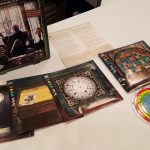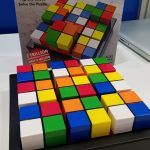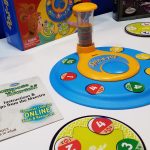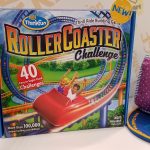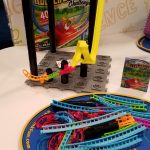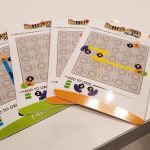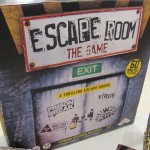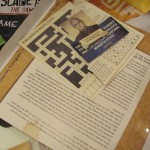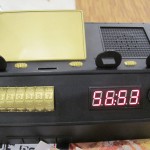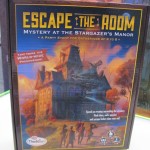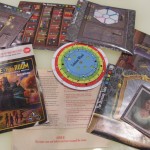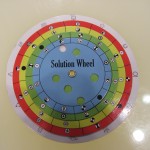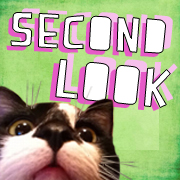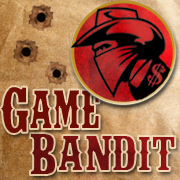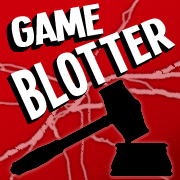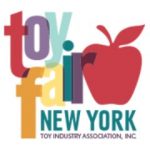 At Toy Fair, ThinkFun’s booth was full of puzzles and a few games. We saw the next entry in their Escape the Room line: Secret of Dr. Gravely’s Retreat (available now, $22). Containing four packed envelopes of props, puzzles, and clues, the new case has a higher age range. “Mystery at the Stargazer’s Manor was big hit for us,” explained Kacey Templin, “but we had a lot of feedback to make the next one a bit more difficult, a bit more adult.” Thus, the recommended age moved slightly forward from 10 to 13 and up.
At Toy Fair, ThinkFun’s booth was full of puzzles and a few games. We saw the next entry in their Escape the Room line: Secret of Dr. Gravely’s Retreat (available now, $22). Containing four packed envelopes of props, puzzles, and clues, the new case has a higher age range. “Mystery at the Stargazer’s Manor was big hit for us,” explained Kacey Templin, “but we had a lot of feedback to make the next one a bit more difficult, a bit more adult.” Thus, the recommended age moved slightly forward from 10 to 13 and up.
Color Cube Sudoku (March, $20) replicates a 6×6 Sudoku puzzle with nine colored cubes. Orient, spin, and swap cubes to solve a Sudoku puzzle using colors instead of numbers.
But I thought the coolest thing there was Spin-A-Roo (in stores in March, $20), a number counting game for the preschooler to second grade set. On your player mat, you have four numbers. You race to grab numbered discs off of the central spin-a-roo piece, either one up or down from the numbers you currently are showing. One neat thing about the game is the spinning element on the central unit: just spin it once and the board is repopulated with tiles — it’s actually fun to set up the next round!
RollerCoaster Challenge (summer, $22) is designed by the person that created Gravity Maze. In this, you’re taking several roller coaster elements, and buildling out tracks. You can try one of the forty challenge cards that come with the game, or — as I suspect I’d do — just use it to build your own coaster set. Currently on Kickstarter — ThinkFun’s first foray using the crowdsourcing platform — backers can receive an exclusive ThinkFun-colored blue car.
- Comments Off on Toy Fair 2017—ThinkFun
Escape rooms, one of the hottest new trends in entertainment, are a kind-of live adventure game. Participants are locked in a room or similar location and given usually about an hour to solve puzzles and follow a series of clues that finds the key and lets them out. Most are built around a theme or story and designed for groups of 4-6 friends.
But though escape rooms are popping up in many urban locations, they’re not accessible to many people, can sometimes be difficult to schedule, and can cost a hundred dollars or more for a 1 hour session. Enter several companies offering escape rooms to go.
Developed by Identity Games and licensed for North American distribution by Spin Master, Escape Room The Game is a $40 package due in the summer that can run 2-5 participants through four different rooms. The clues, puzzles, and mysteries for each room are contained in three envelopes. When participants believe they have solved an envelope, they choose one of the included keys and plug it in to the game’s electronic timer, called a “chrono decoder”. If they’re correct, they can move on to the next envelope. If not, the chrono decoder imposes a time penalty. Though the base game is not yet at retail, Identity is already at work on expansion packs, which should make use of the same chrono decoder.
Another at-home option, ThinkFun’s Escape the Room: Mystery at the Stargazer’s Manor, addresses the problem of hiding answers with a “solution wheel” rather than something electronic. The game begins with the reading of a scene card and proceeds along a story line. Every puzzle solved on the way leads to a symbol and those symbols have to line up in a certain way on the wheel in order to trigger the next stage of the mystery. Due in March, Mystery at the Stargazer’s Manor is just a single room activity but is timed at 90 minutes and priced at only $22.
There’s also the Escape Room In A Box: The Werewolf Experiment Kickstarter project. At $45, this one is also only a single room game. However, it is a more handcrafted experience with jars, locks, and other more substantial elements. Also, certain replacement parts will be available, so that the kit can be used to host other teams.
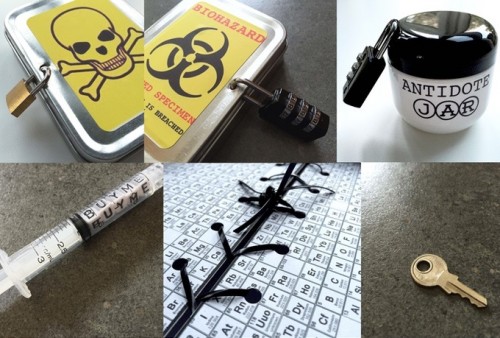
- Comments Off on Escape Rooms on the Go
Trending
- Massdrop.com
- Oh the Irony—Illuminati Card Game Continues to Inspire Conspiracy Theorists
- Footprints, an Educational Ecology Game
- Home
- USPS Adds Board Game Flat Rate Box
- Baila, the Estonian Drinking Card Game
- Crystal Caste Wins Dice Patent Suit Against Hasbro
- Mirror Game, Red and Blue
- Are Board Games Dangerous?
- Board Games Based on Hindu Mythology
Archives
Most Popular Articles
- Oh the Irony—Illuminati Card Game Continues to Inspire Conspiracy Theorists
- The 20 Most Valuable Vintage Board Games
- The Truth About Dominoes On Sunday in Alabama
- Sequence Game, and Variants
- USPS Adds Board Game Flat Rate Box
- Baila, the Estonian Drinking Card Game
- The 13 Most Popular Dice Games
- Are Board Games Dangerous?
- Guess Who? The Naked Version
- What Happened to the Jewel Royale Chess Set?
Recent Posts
- Toy Fair 2019—Breaking Games
- Talisman Kingdom Hearts Edition
- Toy Fair 2019—Winning Moves
- Toy Fair 2019—Games Workshop
- Toy Fair 2019—Star Wars Lightsaber Academy
- Toy Fair 2019—Stranger Things Games
- Toy Fair 2019—HABA
- Licensing Roundup
- Game Bandit
- 2018 A Difficult Year For Hasbro But Not For D&D Or MtG
Recent Comments
- on Toy Fair 2019—Winning Moves
- on Game Bandit
- on Second Look—Dungeons & Dragons Waterdeep Dragon Heist
- on Crowdfunding Highlights
- on Beyblade SlingShock
- on Game Bandit
- on Game Bandit
- on Watch This Game!, the Board Game Review Board Game
- on Second Look—Vampire: The Masquerade 5th Edition
- on Palladium Books Loses Robotech IP License, Cancels Five-Year-Overdue Robotech RPG Tactics Kickstarter


